
The full image of the Parthenon frieze digitally in an online application
The Parthenon frieze is digitally available to everyone in a new, interactive, bilingual and easy-to-use web application. At www.parthenonfrieze.gr both the general public and experts have the opportunity to obtain a complete picture of this unique work of art. The application collects photos and descriptions of all the surviving frieze stones found in the Acropolis Museum and abroad.
The frieze of the Parthenon, a continuous zone with relief representations that surrounded the upper part of the temple wall, depicts the procession to the Acropolis during the Great Panathenaic Games, the largest celebration of ancient Athens. The composition of the procession included 378 human figures, men and women, pedestrians, horsemen and chariots, and more than 200 animals and objects and gifts to Athena, protector of Athens.
The application, which offers users an interactive browsing experience, was realized thanks to the excellent and long-term cooperation of three bodies: the National Center for Documentation and Electronic Content (ECB), the Acropolis Museum and the Acropolis Monuments Preservation Service (YSMA). The ESF developed the upgraded version of the internet application www.parthenonfrieze.gr, utilizing photographic material of YSMA and applying modern technologies for its virtual representation and the optimal promotion on the internet.
The application incorporates new functionalities that make it accessible to all, from all modern media and platforms, following the good practices of web design and UI / UX. Thus, the view from all fixed and mobile devices is enhanced, while the user can reach any level of detail he desires in a direct and friendly way.
The exploration of the frieze of the Parthenon is done through four sections, covering the needs of researchers, with all the necessary documentation and an extensive glossary, while at the same time the ordinary visitor can immediately have an overall picture of this unique archaeological monument.
The section “The Parthenon” includes texts and audiovisual material for the architecture and sculptural decoration of the temple. In the section “Meet the Frieze” the user has the opportunity to get general information about the theme, history, design and construction of the frieze.
In the section “Explore the frieze” the user can explore the frieze by side and by stone. The “Thematic Tour” allows the user to approach the frieze through its individual topics: the preparation of the procession, the riders participating in the procession, the chariots, the procession of offerings and animals for sacrifice and finally the delivery of the veil to the goddess Athena in the presence of the gods of Olympus.
In the internet application parthenonfrieze.gr , photographic material of all the surviving frieze stones is collected and memorized, in Greek and English. At the same time, in order to give the most complete picture of this wonderful ensemble, the photographic material of the stones is supplemented with the surviving drawings of J. Carrey (1674) and J. Stuart (1751).
Of the total frieze today, 50 meters are preserved in the Acropolis Museum and 80 meters in the British Museum. A stone is in the Louvre Museum and some fragments are scattered in various European museums in Palermo, the Vatican, Würzburg, Vienna, Munich and Copenhagen.
In January 2022 the “Fagan fragment” from the Antonino Salinas Museum in Palermo returned to Athens to be exhibited for 8 years at the Acropolis Museum and took its place in the eastern frieze of the Parthenon, where the Gods of Olympus are represented. Until the reunion of all the surviving stones and fragments of the frieze in their natural space, lovers of ancient Greek history will be able to admire the masterpiece designed by the sculptor Pheidias, in the fifth century BC, in the new web application of the ESF.
The frieze of the Parthenon, with a total length of 160 meters and a height of almost 1 meter, was designed by the sculptor Pheidias and circled the upper part of the nave, the main temple, through its outer colonnade. The subject of covering such a long and at the same time narrow surface had to be multifaceted and as such it was considered appropriate to represent a procession.
The theme of the Parthenon frieze is the procession of the Panathenaeans, the culmination of the feast of the Great Panathenaeans. The frieze consisted of 115 stones, of various sizes, with continuous relief representations of people and animals. The composition of the procession included 378 figures, gods, heroes of the city, lords, citizens, men and women, children, young and old, as well as more than 200 animals, mainly horses, but also oxen and rams.
There are four sections in the whole project: The preparation of the procession, the main procession with the lineup of horsemen and chariots, the procession of offerings and animals for sacrifice and the main worship with the delivery of the veil.
The procession to the frieze starts from the southwest corner of the temple and is divided into two factions that run east. One line continues along the south side, while the other, after crossing the west side, continues along the north side and both end on the east side. On the west and north sides the figures walk from the right to the left of the viewer, while on the south from the left to the right.
A long-term collaboration with significant results and multifaceted benefits
YSMA, the Acropolis Museum and the ESF in the last twenty years, through their multifaceted collaborative activities, have charted a parallel digital course in the cultural and educational events of the country, providing the public with a number of modern digital infrastructure.
Dr. DeepMind – the Google-only branch of artificial intelligence – led by researcher Dr. Giannis AssaelThea Sommerschield of the Department of Humanities at Ca ‘Foscari University in Venice, School of Classical Studies. Oxford and the Department of Informatics of the Athens University of Economics and Business to create “Ithaca”, the first neural network for the restoration of text of damaged inscriptions and the determination of their place and date of writing. Their findings were published Thursday in the leading scientific journal “Nature”, with “K” being the only Greek media outlet that has the exclusive information behind the groundbreaking work.










